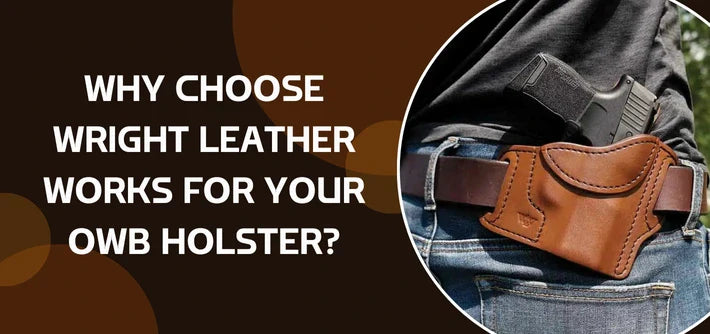Carrying a firearm is a responsibility. If you carry OWB holsters, you are already aware of the practicality and comfort they offer. But comfort should never come before safety. Whether you are a novice or seasoned carrier, it is important to know how to handle your OWB holster safely.
Let’s take a look at the top OWB Holster Safety tips that will help you feel confident and in control each time you carry your firearm.
What Is an OWB Holster?
OWB stands for "Outside the Waistband." This is one of the more commonly seen types of gun holsters. As the name suggests, the holster itself is located outside your pants and attached to your belt.
This type of holster is popular in part because drawing your firearm from it is simple and relatively fast. Many law enforcement officers, security personnel, and civilian carriers prefer OWB holsters for open carry or at the range.
Since your firearm is out and visible to others and accessible for you to draw, you will want to focus even more on OWB Holster Safety.
1. Choose the Right OWB Holster
To start protecting yourself, you will need to find the right holster first. An OWB holster should fit your gun properly. If the fit is loose, it could cause problems. The gun could slip out or shift as you move.
Always choose a holster designed for your exact firearm. If possible, avoid a universal fit. It is also important that the holster and the retention system are firm yet smooth. When the gun is secure, you should hear or feel a "click" type of sound.
Also consider the holster's material. High-quality leather, Kydex, or polymer holsters are good options. Cheap or soft holsters can wear out and, in turn, lead to a loss of retention.
2. Secure the Holster Properly
Even the most reliable holster may fail if it is not mounted securely. Verify that your OWB holster is securely attached to your belt. You will need a belt that is strong, stiff, durable, and made for carrying.
Regular belts might not provide enough support. You may find them sagging under the weight of your firearm. When your holster shifts, your firearm will also shift. This increases the likelihood of accidental exposure or a missed draw.
Before leaving your home or vehicle, test your holster by bending, moving, and walking. It should remain still and feel balanced on your waist.
3. Keep Trigger Discipline Always
This is an undisputed rule - do not put your finger on the trigger until you are prepared to pull. Many unintentional discharges occur simply because this critical step is forgotten.
When drawing from or re-holstering, keep your finger straight and parallel with the frame of the gun and outside of the trigger guard, and only move that finger to the trigger when the target is identified and when you're prepared to fire.
Even with a holster that covers the trigger guard, careless or haphazard actions can lead to unintentional discharges. Stay attentive when handling your firearm.
4. Be Mindful When Re-holstering
One of the most common errors with OWB holsters occurs during re-holstering. Too many shooters hurry through this process. Don’t rush.
When re-holstering, do so slowly and deliberately. You want to be entirely sure that all clothing, the belt, or other accessories are not interfering with the holster. A piece of clothing can get close to the trigger and create a dangerous discharge.
Take your time; if you have to look down, do it. Slow and smooth is always better than fast and sloppy.
5. Check Your Holster Condition Regularly
Your OWB holster is worn every day. Sweat, friction, and movement may affect its performance over time, and even the material can stretch, crack, and loosen.
Be sure to inspect your holster frequently. Check the screws, retention clips, and edges. If it feels loose or worn, replace it. A damaged holster is not worth the risk. OWB Holster Safety should be treated as a habit, not as an act that is done once.
6. Keep Your Gun Covered in Public
If you carry openly with an OWB holster, you can't help but attract attention. Some people will be uncomfortable; some will see it as an opportunity. Those people may take action, for example, to control you or your weapon.
Whenever reasonable, wear a jacket, long shirt, or other light cover garment. This, of course, gives you some discretion and protects your weapon from curious hands.
Situational awareness is infused into your OWB Holster Safety. Always be attentive to who is near and how you are positioning your body. Avoid bending or turning in a way that exposes the gun unnecessarily.
7. Treat Every Gun as Loaded
Even if you are convinced it is empty, you must act as if it is loaded. This viewpoint will eliminate careless mistakes.
Anytime you handle, clean, or store your gun, check the chamber. Never assume but always verify. If you maintain this discipline, treating your OWB Holster Safety with the respect and ownership it deserves will become automatic.
8. Be Careful Around Others
When you are with your friends or family, be aware of your movements. Don't trivialize or handle your firearm. This is not a toy or an item of conversation.
Always ensure children or those who are not trained have zero access to your firearm. Whenever you take your holster off, place it in a locked and secure place.
Your mindfulness and accountability keep those around you safe.
9. Learn from Every Experience
Every time you carry your OWB holster, you are teaching yourself something new. Maybe the belt needs to fit better, or the drawing angle feels off, or perhaps the retention feels too loose.
Keep observing and changing. The best shooters are those who continue to learn. Your end goal is not just to carry safely, but to master control and awareness in every situation.
Final Thoughts
Safety is not about completing a list of tasks; it is a way of thinking. The good carriers are those who handle each tensor with care and consideration of their responsibility, from draw to re-holster.
A practical outside-the-waistband holster will allow you to successfully carry and access your firearm with greater comfort and efficiency. But if you do not have good safety habits, you can have the best gear available and still fail.
So be diligent. Frequent practice and awareness are immensely valuable. An honest respect for your weapon and everything around you is paramount. If you follow the recommendations in this OWB Holster Safety article every time you carry, you will not only be confident but truly safe.






Leave a comment (all fields required)